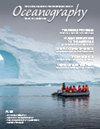The Intertwined Futures of Whales and Humans
IF 2.8
4区 地球科学
Q1 OCEANOGRAPHY
引用次数: 0
Abstract
16 IF YOU COULD somehow ask a North Atlantic right whale what she thinks the future holds, what would she say? Right whales must, in some way, think about the future in order to make survival decisions. As an ocean science community, our eyes are trained increasingly on the future as well. The twin global environmental crises of climate change and biodiversity loss have elevated the science of real-world prediction to one of urgent interest. At timescales ranging from hours to decades, society is asking ocean science for actionable predictions, projections, and forecasts, with the hope of mitigating and adapting to the changing ocean. Meeting this challenge requires more than the ability to predict ocean dynamics. For highly endangered species like the North Atlantic right whale (Eubalaena glacialis), better foresight might have prepared us for the changes that recently led to a catastrophic unusual mortality event (UME). Predictable oceanographic changes in turn drove changes in right whale migration and calving, reversing what had been a recovery of the species. Now, fewer than 400 of them remain alive. For many of us working in right whale science, policy, and management, we are haunted by questions of how the UME might have been anticipated and prevented and how we might prevent something similar in the future. The oceanography itself, while crucial, is only half of the equation. As Meyer-Gutbrod et al. (2021, in this issue) detail in their analysis, the oceanographic mechanisms behind the recent changes are well understood by the oceanographic community. Warming has led to shifts in ocean currents like the Gulf Stream, which influence the source of deep-water supply to the Gulf of Maine (Neto et al., 2021). Changes in deepwater conditions alter the availability of right whales’ primary prey, Calanus finmarchicus (Record et al., 2019). Without a reliable supply of prey, foraging patterns have changed, broadening the range outside of protected areas, leading to higher mortality (Davies and Brillant, 2019) and reduced calving, and thus putting the species at significant risk of extinction (Meyer-Gutbrod et al., 2021, in this issue). PERSPECTIVE鲸鱼与人类交织的未来
16如果你能问北大西洋露脊鲸她认为未来会怎样,她会怎么说?露脊鲸必须以某种方式思考未来,才能做出生存决定。作为一个海洋科学界,我们的眼睛也越来越关注未来。气候变化和生物多样性丧失这两大全球环境危机使现实世界预测科学成为人们迫切关注的问题之一。在从几个小时到几十年的时间尺度上,社会要求海洋科学提供可操作的预测、预测和预测,以期缓解和适应不断变化的海洋。应对这一挑战需要的不仅仅是预测海洋动力学的能力。对于北大西洋露脊鲸(Eubalaena glacialis)等高度濒危物种来说,更好的远见可能会让我们为最近导致灾难性异常死亡事件(UME)的变化做好准备。可预测的海洋学变化反过来推动了露脊鲸迁徙和产仔的变化,扭转了该物种的复苏。现在,他们中只有不到400人还活着。对于我们许多从事露脊鲸科学、政策和管理工作的人来说,我们一直被如何预测和预防UME以及我们如何在未来防止类似的事情的问题所困扰。海洋学本身虽然至关重要,但只是等式的一半。正如Meyer Gutbrod等人(2021,本期)在他们的分析中详细描述的那样,海洋学界对最近变化背后的海洋学机制有着深刻的理解。变暖导致了墨西哥湾流等洋流的变化,这影响了缅因湾深水供应的来源(Neto等人,2021)。深水条件的变化改变了露脊鲸主要猎物Calanus finmarchicus的可用性(Record等人,2019)。在没有可靠猎物供应的情况下,觅食模式发生了变化,扩大了保护区以外的范围,导致更高的死亡率(Davies和Brillant,2019)和产仔减少,从而使该物种面临重大灭绝风险(Meyer Gutbrod et al.,2021,在本期中)。透视
本文章由计算机程序翻译,如有差异,请以英文原文为准。
求助全文
约1分钟内获得全文
求助全文
来源期刊

Oceanography
地学-海洋学
CiteScore
6.10
自引率
3.60%
发文量
39
审稿时长
6-12 weeks
期刊介绍:
First published in July 1988, Oceanography is the official magazine of The Oceanography Society. It contains peer-reviewed articles that chronicle all aspects of ocean science and its applications. In addition, Oceanography solicits and publishes news and information, meeting reports, hands-on laboratory exercises, career profiles, book reviews, and shorter, editor-reviewed articles that address public policy and education and how they are affected by science and technology. We encourage submission of short papers to the Breaking Waves section that describe novel approaches to multidisciplinary problems in ocean science.
 求助内容:
求助内容: 应助结果提醒方式:
应助结果提醒方式:


